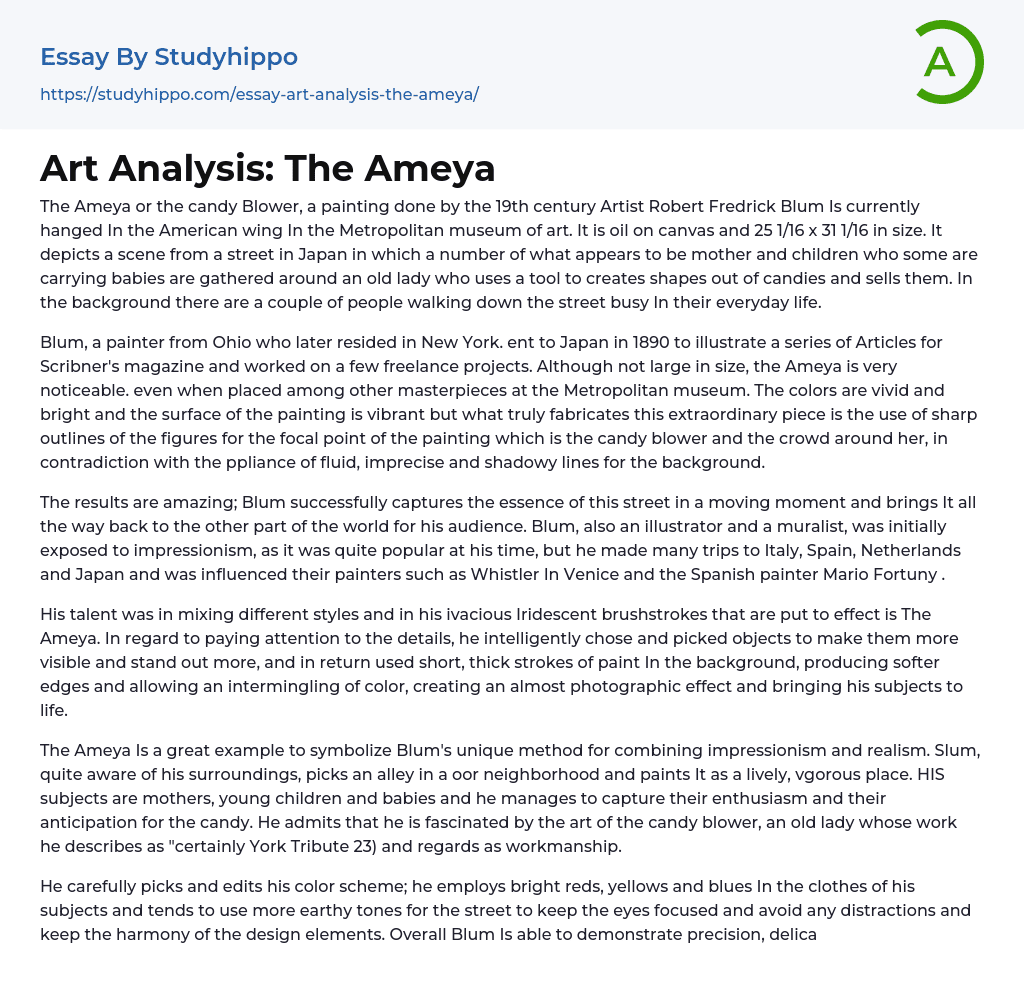The Ameya or the candy Blower, a painting done by the 19th century Artist Robert Fredrick Blum Is currently hanged In the American wing In the Metropolitan museum of art. It is oil on canvas and 25 1/16 x 31 1/16 in size. It depicts a scene from a street in Japan in which a number of what appears to be mother and children who some are carrying babies are gathered around an old lady who uses a tool to creates shapes out of candies and sells them. In the background there are a couple of people walking down the street busy In their everyday life.
Blum, a painter from Ohio who later resided in New York. ent to Japan in 1890 to illustrate a series of Articles for Scribner's magazine and worked on a few freelance projects. Although not large in size, the Am
...eya is very noticeable. even when placed among other masterpieces at the Metropolitan museum. The colors are vivid and bright and the surface of the painting is vibrant but what truly fabricates this extraordinary piece is the use of sharp outlines of the figures for the focal point of the painting which is the candy blower and the crowd around her, in contradiction with the ppliance of fluid, imprecise and shadowy lines for the background.
The results are amazing; Blum successfully captures the essence of this street in a moving moment and brings It all the way back to the other part of the world for his audience. Blum, also an illustrator and a muralist, was initially exposed to impressionism, as it was quite popular at his time, but he made many trips
to Italy, Spain, Netherlands and Japan and was influenced their painters such as Whistler In Venice and the Spanish painter Mario Fortuny .
His talent was in mixing different styles and in his ivacious Iridescent brushstrokes that are put to effect is The Ameya. In regard to paying attention to the details, he intelligently chose and picked objects to make them more visible and stand out more, and in return used short, thick strokes of paint In the background, producing softer edges and allowing an intermingling of color, creating an almost photographic effect and bringing his subjects to life.
The Ameya Is a great example to symbolize Blum's unique method for combining impressionism and realism. Slum, quite aware of his surroundings, picks an alley in a oor neighborhood and paints It as a lively, vgorous place. HIS subjects are mothers, young children and babies and he manages to capture their enthusiasm and their anticipation for the candy. He admits that he is fascinated by the art of the candy blower, an old lady whose work he describes as "certainly York Tribute 23) and regards as workmanship.
He carefully picks and edits his color scheme; he employs bright reds, yellows and blues In the clothes of his subjects and tends to use more earthy tones for the street to keep the eyes focused and avoid any distractions and keep the harmony of the design elements. Overall Blum Is able to demonstrate precision, delicacy and above all a regard to the Joys of life in this painting. With his talented brushstrokes he tends to grasps the t Of the background, the cheerful and excited looks of the children and the
focused ameya making candy all in a timeless, marvelous artwork.
- Russian Empire essays
- Ancient Greece essays
- British Empire essays
- Historical Figures essays
- Nazi Germany essays
- Roman Empire essays
- War essays
- Revolution essays
- 19Th Century essays
- Historiography essays
- History of the United States essays
- 20Th Century essays
- World History essays
- Vikings essays
- Declaration of Independence essays
- Civilization essays
- Evidence essays
- Genocide essays
- Colonialism essays
- Rebellion essays
- 1960S essays
- 1920S essays
- 1950S essays
- Letter from Birmingham Jail essays
- Louisiana Purchase essays
- The Columbian Exchange essays
- World Hunger essays
- What is History essays
- Bravery essays
- Gilded Age essays
- Vladimir Lenin essays
- Alexander The Great essays
- Sparta essays
- Victorian Era essays
- Henry v essays
- Stonehenge essays
- Frederick Douglass essays
- Mahatma Gandhi essays
- Joseph Stalin essays
- Geert Hofstede essays
- George Eliot essays
- Ginevra King essays
- John Keats essays
- Siegfried Sassoon essays
- Ben jonson essays
- Billy elliot essays
- Wilkie collins essays
- John Proctor essays
- Harriet Tubman essays
- Napoleon essays




